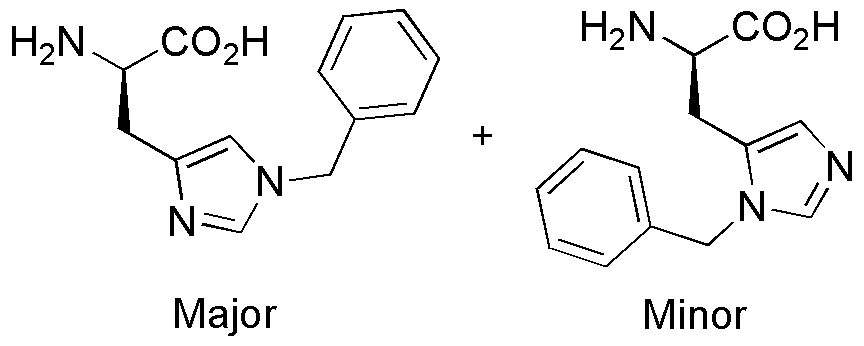Nim-Benzyl-D-histidine is widely utilized in research focused on:
- Pharmaceutical Development: This compound serves as a building block in the synthesis of novel drugs, particularly in the development of peptide-based therapeutics that target specific biological pathways.
- Biochemical Research: It is used to study the interactions of histidine derivatives with proteins, aiding researchers in understanding enzyme mechanisms and protein folding.
- Diagnostic Applications: Nim-Benzyl-D-histidine can be employed in the formulation of diagnostic agents, enhancing imaging techniques in medical diagnostics.
- Neuroscience Studies: This compound plays a role in research related to neurotransmitter systems, helping to explore potential treatments for neurological disorders.
- Material Science: It is applied in the development of smart materials that respond to environmental stimuli, showcasing its versatility beyond traditional chemical applications.
General Information
Properties
Safety and Regulations
Applications
Nim-Benzyl-D-histidine is widely utilized in research focused on:
- Pharmaceutical Development: This compound serves as a building block in the synthesis of novel drugs, particularly in the development of peptide-based therapeutics that target specific biological pathways.
- Biochemical Research: It is used to study the interactions of histidine derivatives with proteins, aiding researchers in understanding enzyme mechanisms and protein folding.
- Diagnostic Applications: Nim-Benzyl-D-histidine can be employed in the formulation of diagnostic agents, enhancing imaging techniques in medical diagnostics.
- Neuroscience Studies: This compound plays a role in research related to neurotransmitter systems, helping to explore potential treatments for neurological disorders.
- Material Science: It is applied in the development of smart materials that respond to environmental stimuli, showcasing its versatility beyond traditional chemical applications.
Documents
Safety Data Sheets (SDS)
The SDS provides comprehensive safety information on handling, storage, and disposal of the product.
Product Specification (PS)
The PS provides a comprehensive breakdown of the product’s properties, including chemical composition, physical state, purity, and storage requirements. It also details acceptable quality ranges and the product's intended applications.
Certificates of Analysis (COA)
Search for Certificates of Analysis (COA) by entering the products Lot Number. Lot and Batch Numbers can be found on a product’s label following the words ‘Lot’ or ‘Batch’.
*Catalog Number
*Lot Number
Certificates Of Origin (COO)
This COO confirms the country where the product was manufactured, and also details the materials and components used in it and whether it is derived from natural, synthetic, or other specific sources. This certificate may be required for customs, trade, and regulatory compliance.
*Catalog Number
*Lot Number
Safety Data Sheets (SDS)
The SDS provides comprehensive safety information on handling, storage, and disposal of the product.
DownloadProduct Specification (PS)
The PS provides a comprehensive breakdown of the product’s properties, including chemical composition, physical state, purity, and storage requirements. It also details acceptable quality ranges and the product's intended applications.
DownloadCertificates of Analysis (COA)
Search for Certificates of Analysis (COA) by entering the products Lot Number. Lot and Batch Numbers can be found on a product’s label following the words ‘Lot’ or ‘Batch’.
*Catalog Number
*Lot Number
Certificates Of Origin (COO)
This COO confirms the country where the product was manufactured, and also details the materials and components used in it and whether it is derived from natural, synthetic, or other specific sources. This certificate may be required for customs, trade, and regulatory compliance.

